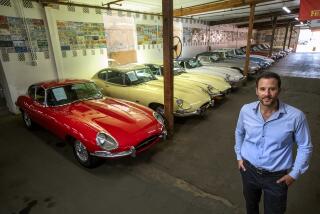Classic Cars Seen as Smart Investments Among High-Rollers and the New Rich
- Share via
LONDON — “The badge with the prancing horse on the bonnet (car hood)--you can’t go wrong,” said one city whiz kid on the latest investment fad to hook the world’s rich.
Thoroughbred classic cars, with their stylish lines and racing pedigrees, have suddenly caught the imagination of auction houses, speculators and dealers.
Ferraris have led the field, commanding astonishing prices at classic car auctions, as the yellow emblem with a rearing black stallion sends high-rollers reaching for their checkbooks.
International trade in such charismatic marques as Ferrari, Maserati, Aston Martin, De Tomaso and Hispano Suiza is worth more than $1 billion a year.
Appeal to the New Rich
Like investments in wine and art, classic cars appeal particularly to the new rich who want a unique car that is a good investment and a symbol of wealth and success.
“It’s far more fun to have a gleaming sports car than a fat bank account,” said Stewart Skilbeck, a consultant for Sotheby’s.
Sotheby’s and Christie’s, the two top British auction houses, have been at the forefront of the boom, organizing prestige sales at glamorous locations.
The investment performance of some classic cars, especially from the 1960s, has far outpaced stocks, causing analysts to ask just how big the bubble can grow and if it will burst.
Canny used-car salesmen are using their skills to move up in the market. A welter of specialist dealers have sprung up.
The global stock market crash of October, 1987, disconcerted many rich investors who afterward looked for alternative havens for their cash. Some chose cars as investment vehicles.
A 1931 Bugatti Royale sport coupe became the most expensive car to be sold at auction when Christie’s brought the hammer down on a $9-million bid in November, 1987.
‘New Faces, New Money’
“After the crash, there was new interest in the car world. New faces, new money,” Skilbeck said. “Some had their fingers burned and reckoned it’s better to have a vintage Bentley in the garage than a worthless piece of paper in your office drawer.”
Prices also accelerated with the death a year ago of Enzo Ferrari, the great man of racing whose name became synonymous with success, elegance and breathtaking speed.
A Ferrari 250 GTO made in 1964 cost $12,450 in 1974 and was worth $415,000 in 1984. Dealers say it could now fetch $5 million at auction today.
Recently, the rise in Ferrari price tags has started to slow down, giving other makers, such as Aston Martin and Alfa Romeo, a chance to catch up.
“The Ferrari market is taking a pause,” Skilbeck said.
At a recent Sotheby’s auction in Monaco, a 1963 Ferrari 250 GT did not sell. But many other cars did.
At Christie’s Monaco auction in May, seven cars sold for more than $1.6 million.
At the Sotheby’s auction, a brand-new Ferrari Testarossa, which means redhead, was sold for more than 50% above list price because of factory waiting lists.
Why Old, Not New?
Why do people buy old Ferraris rather than new Ferraris? “Why do you buy a Victorian house rather than a brand-new house,” Christie’s Martin asked.
Many buyers of classic 1960s sports cars are buying the dream of their teen-age years. “Pure nostalgia,” one buyer said.
Classic cars have also become a recognized form of investment, with very good rates offered on loans for vehicles.
“You’re also buying a work of art,” one dealer said.
When you sell a Maserati in Britain, for example, and take a profit, there is no capital-gains tax. “You can enjoy it far more than a painting or a bit of silver,” the dealer said.
“It’s hard to steal, they’re getting scarcer and it’s a movable asset,” he said, adding: “If you buy a house in the United States, you can’t ship it over here.”
Collectors’ cars are also easier to drive than ever. Spare parts are more readily available, insurance packages involving limited mileage are relatively inexpensive and there is a multitude of annual rallies.
The prestige Mille Miglia (thousand-mile) race in Italy attracts the cream of the world’s collector cars.
But Skilbeck warned would-be speculators that they must have an interest in the car they are buying and understand that they are entering a temperamental market.
“They must be enthusiast-owned or maintained to climb in value,” he said. “There’s no use putting 100 cars in a warehouse and leaving them as they will suffer and depreciate.”
Skilbeck, however, predicted steady growth in the passion for classic cars--and corresponding price rises.
“Man’s love affair with the motorcar comes very close behind his love of the female form,” he said.






